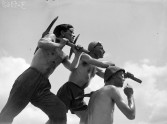
Discovering Georgian Cinema—The Silent Era
Whenever Georgian cinema is mentioned, even a seasoned film buff will most likely think of towering auteurs from the 1950s through the 1980s—Otar Iosseliani, Giorgi Shengelaia or Tengiz Abuladze. No doubt, these directors, with their unique combination of visual poetry and insightful reflection on things human and social (think of Abuladze’s anti-Stalinist Repentance that shook the Soviet Union in 1987; perhaps no less than ten days in October 1917 are said to have shaken the world) more than deserve their renown (and, let us hope, a separate retrospective here at the Harvard Film Archive). Yet, as tends to happen with many a historical myth, by foregrounding an individual epoch we risk reducing the ones that preceded and followed it to mere before and after, a dim antechamber and bleak postscript to the “Golden Age.”
The history of Georgian cinema is a case in point. We ought to be wary of singling out the post-war Georgian auteurs at the expense of Georgian silent film legacy or the cinema of independent Georgia (1991 till now). This mini-retrospective is our humble tribute to the former. Silent cinema in Georgia saw three political regimes. It goes back to the last years of the country still being a province of the Russian Empire (1801 to 1917); filmmaking continued during the three years of independent Democratic Republic of Georgia (1918 to its annexation by Soviet Russia in 1921), and then went on into the twenties and thirties when Georgia became a part of the USSR.
With the whole of the Soviet Union its primary market, Georgian films stood out immediately. Little Red Devils, arguably the most popular film of the Soviet twenties, was made in Georgia in 1923. With its legendary ancient culture and gorgeously picturesque nature, Georgian filmmakers had literally a lot to show to the viewers. That certainly helped (from our selection, Eliso and Salt for Svanetia are especially breathtaking in this regard), but it is hardly a sufficient explanation. In addition, Georgia’s cultural diversity was a bottomless resource for filmmakers to exploit: from indigenous mountaineers, rural winemakers and traditional local military to urban proletariat, folk artisans and highly educated intelligentsia, and encompassing Christian, Muslim and pagan beliefs and rituals, Georgia, then a nation of less than three million, had it all.
Complementary to Georgia’s ancientry was a powerful Georgian avant-garde movement in different arts, from poetry to sculpture, that in the 1910s and early 20s nurtured future Georgian filmmakers and powered their appetite for experiment—until, by a direct order from Moscow, artistic experiments and movements were banned anywhere in the Soviet Union (two of our films, Salt for Svanetia and Nail in the Boot, were banned as well).
All four films we are screening were made by three filmmakers early in their careers. Their backgrounds and subsequent fates were different, but equally telling. Nikoloz Shengelaia was a poet before turning to film, twenty-five years old when he made Eliso (1928), a film that remains a cornerstone of his legacy; Shengelaia died at forty in Tbilisi, and was survived by two sons, Eldar and Giorgi, both of whom became prominent Georgian filmmakers. Mikheil Chiaureli made Saba (1929), his second feature, at the age of thirty-five, after a serious career in visual art and theater; he went on to make films for four more decades before his death in 1973 in Tbilisi, becoming one of the most decorated filmmakers in the Soviet Union, mainly for creation of cinematic Staliniana (in the late thirties and forties, he made three films focused on Stalin’s life achievements, all to the liking of their subject, who made Chiaureli his frequent drinking buddy). Finally, the director of Salt for Svanetia (1931) and Nail in the Boot (1932) was born Mikheil Kalatozishvili in Tbilisi and died Mikhail Kalatozov in Moscow. Only one of his films, The Cranes are Flying (1957), achieved immediate international acclaim (the only Soviet film ever to win the Palme d’Or at Cannes); several others, including both of the silents we are screening, as well equally daring Soy Cuba (I am Cuba, 1964), were so unusual in film style and technique that they had to wait decades to be rediscovered and to receive the deserved applauses, restorations and, most importantly, screenings. – Daria Khitrova, Associate Professor of Slavic Languages and Literatures, Harvard






